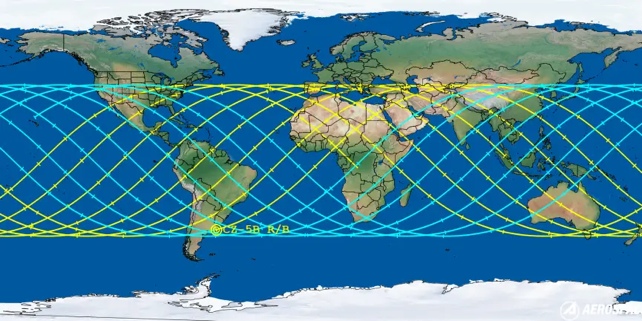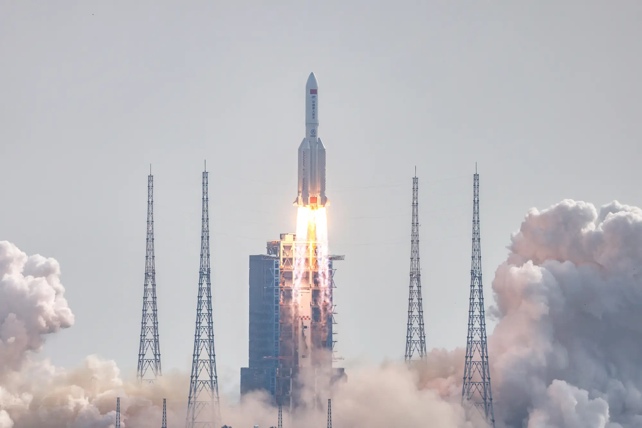China successfully launched the third and final piece of its new Tiangong space station on Monday – and the rocket's 23-ton body is coming back down somewhere on Earth this weekend.
The Mengtian module, which carries science experiments, blasted off on China's Long March 5B rocket. As it climbed into space, the rocket's core stage gave the space-station module one last push into Earth's orbit before detaching itself.
Unlike most modern rocket bodies, which are designed to push themselves into a remote part of the Pacific Ocean, the Long March 5B body fell into its own orbit around Earth.
It's on track to descend into the atmosphere again – an event called "reentry" – and fall to Earth on Friday or in the morning Saturday in the Eastern time zone.
No one knows where the rocket body will fall, and nobody is controlling it. But it's extremely unlikely that any debris from space will hit you.
Forecast: It's going to rain rocket parts
Experts can only estimate how much of the Long March rocket body, which is roughly the size of a 10-story building, will slam into the Earth. Some of it will likely burn up as it plows through the atmosphere, but the rocket body is too large to completely disintegrate.
A rule of thumb is that 20 percent to 40 percent of a large object's mass will survive its fall through the atmosphere, experts at the Aerospace Corporation previously told Insider.
It's still too early to tell exactly where the core stage might fall – most likely in pieces. But the Aerospace Corporation is tracking the rocket stage and predicting the possible paths it might take back to Earth.

The area where debris could fall covers about 88 percent of the human population, according to those analysts' calculations. But that population is heavily condensed in a few places. Most of the area where debris could rain down is open ocean or uninhabited land.
Still, space-industry leaders have decried China's practice of uncontrolled reentry, saying it poses an unnecessary risk to human life and property.
Estimates will improve in the coming days, as the rocket body gets closer to reentry.
China's rocket debris keeps crashing back to Earth
This marks the fourth time that a remnant from China's Long March 5B rocket has threatened human lives and property. Each of the three times the rocket launched – in 2020, 2021, and in July 2022 – chunks of its body fell back to Earth.
In May 2020, debris from one of those rockets was discovered near two villages in Ivory Coast, reportedly causing property damage. In 2021, China said remnants from the rocket landed in the Indian Ocean near the Maldives, according to The New York Times.

Earlier this year, in July, portions of the rocket's booster also crashed back to Earth, with several likely pieces discovered on both the Malaysian and Indonesian sides of the island of Borneo, as well as in the ocean near the Philippines.
Most rocket stages bring themselves down by reigniting their engines shortly after delivering their cargo to orbit, steering themselves away from populated areas and into the Pacific Ocean. But in the case of the Long March 5B, China didn't design the rocket booster for controlled reentry.
"Rockets get launched all the time, and very seldom is there concern about reentry," John Logsdon, the founder of George Washington University's Space Policy Institute, told Insider in May 2021, as the world waited for the rocket body to fall. "So yeah, I'm a little confused as to why this is happening."
"Is it just willful disregard of the international guidelines? Or because it's a new vehicle, it wasn't properly designed so it could do a controlled reentry? Whatever," Logsdon said, adding, "It's unfortunate that it puts a lot of people at risk."
Space junk could kill someone this decade
In a study published in the journal Nature in July, researchers calculated a roughly 10 percent chance that debris will strike one or more people within a 10-year period. It's not just Chinese rocket bodies. Satellites and chunks of unknown debris fall out of orbit regularly.
"If you roll the dice too many times, someone will get lucky," Jonathan McDowell, a Harvard astronomer who meticulously tracks objects in Earth's orbit, previously told Insider.
Ted Muelhaupt, a consultant who works on the Aerospace Corporation's reentry database, previously told Insider that an object weighting at least 1 ton falls from orbit and reenters the atmosphere on a weekly basis.
The Long March 5B boosters are among the largest objects to fall back to Earth, but uncontrolled reentry isn't unique to China. In 1979, NASA's Skylab space station rapidly descended, scattering debris over Australia. Today, though, controlled reentry is standard practice.
This article was originally published by Business Insider.
More from Business Insider: